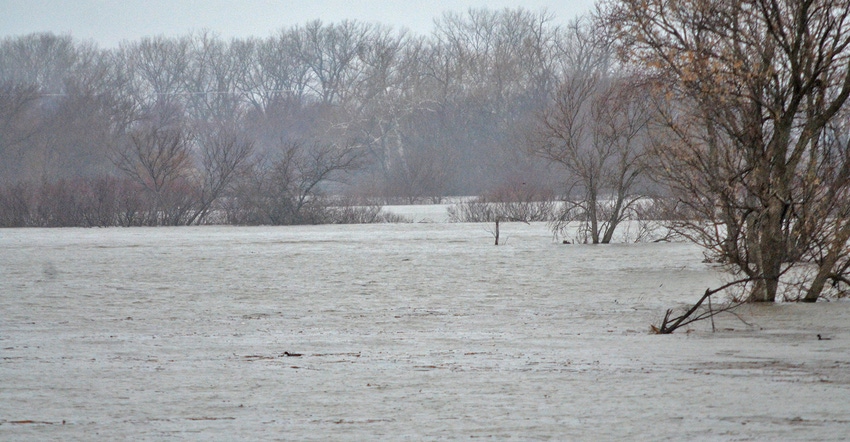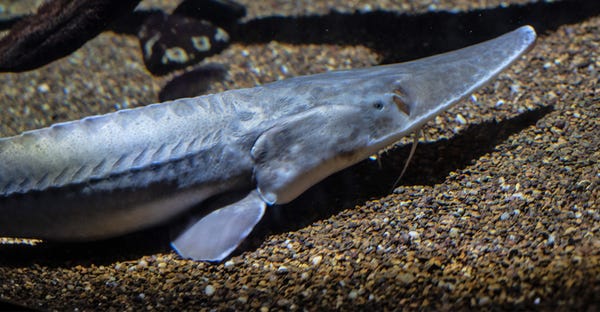May 1, 2019

By Lynn Muench
With heartbreak, we have watched our friends and neighbors across the states of Iowa, Kansas, Missouri and Nebraska suffer from the effects of historic Missouri River flooding caused by severe winter weather. It included the infamous “bomb cyclone” pattern, leaving behind record river stages, a dam failure, and scores of levee breaches with little warning for residents to move personal property, equipment and stored crops.
Much has been said about this event, including criticisms directed toward the U.S. Army Corps of Engineers. While there will be plenty of time to analyze if anything could’ve been done better, we are thankful for the Corps’ efforts on several fronts, including positioning flood control gates at Gavins Point Dam to allow it to hold more than 2 feet of extra water and stopping releases from Fort Randall Dam.
These extraordinary measures undoubtedly prevented further damage.

PROTECTED STATUS: Trying to keep these river fish thriving is a goal of the U.S. Fish & Wildlife Services. It has projects along the Missouri River to establish habitat that some groups say is creating more flood problems.

Who’s to blame
While some are angry about misplaced priorities of the Corps, angst might be better directed at the U.S. Fish & Wildlife Service, which dictates much of the Corps’ actions. We are not implying the service’s directives contributed to this extraordinary flooding, but believe it’s worth pointing out its history of mandates to the Corps.
These include implementation of artificial spring rises, construction of shallow water habitat chutes and notching of rock dikes that control the river’s channel — all unproven experiments to aid endangered pallid sturgeon.
The U.S. Fish & Wildlife Service views the Missouri River as a pallid sturgeon laboratory, and its forced experiments have led to severe riverbank erosion, undercutting of levees and destruction of private property, resulting in a changed river for people who live and work alongside it.
While we support science-based species recovery efforts, any planned habitat construction projects that increase flood risk should be immediately discontinued.
Action required
Going forward, government agencies and stakeholders should engage in renewed discussion on how to enhance flood control throughout the system. While virtually all the discussion has centered on the mainstem Missouri River regulated by dams, it’s worth noting this event primarily originated in the “unregulated” portion of the basin, which produces just less than half of the average runoff into the Missouri River. Any discussion that ignores this important fact misses the mark.
It’s time to redouble our efforts on providing lower Missouri River residents with an improved flood control system that can better withstand events of the magnitude we’re seeing this year. Flood control and protection of human life and property must be paramount in any decisions regarding Missouri River management.
Serious consideration must be given to increased upstream flood control storage, whether that be in the mainstem dams or on tributary projects. Any proposed change in flood control storage must also keep an eye toward times of drought, which the Missouri River system is just as prone to.
In addition, policymakers should consider navigation, which is the other congressionally directed primary purpose of the system, as well as water supply needs for drinking water and utilities that we often take for granted but have an enormous effect in our everyday lives.
We are encouraged by the recent meeting between the governors of Iowa, Missouri and Nebraska and Corps leadership, focusing on solutions to protect against future floods. The governors stated they want to become more active in Missouri River management, and it’s high time they have a prominent seat at the table.
While large floods often create huge amounts of destruction and personal suffering, they also create the chance to be more resilient to future floods. For the benefit of regional economic development and opportunities for future generations, we cannot delay these crucial conversations.
Muench is chairwoman of the Coalition to Protect the Missouri River. She is based out of St. Louis.
You May Also Like




